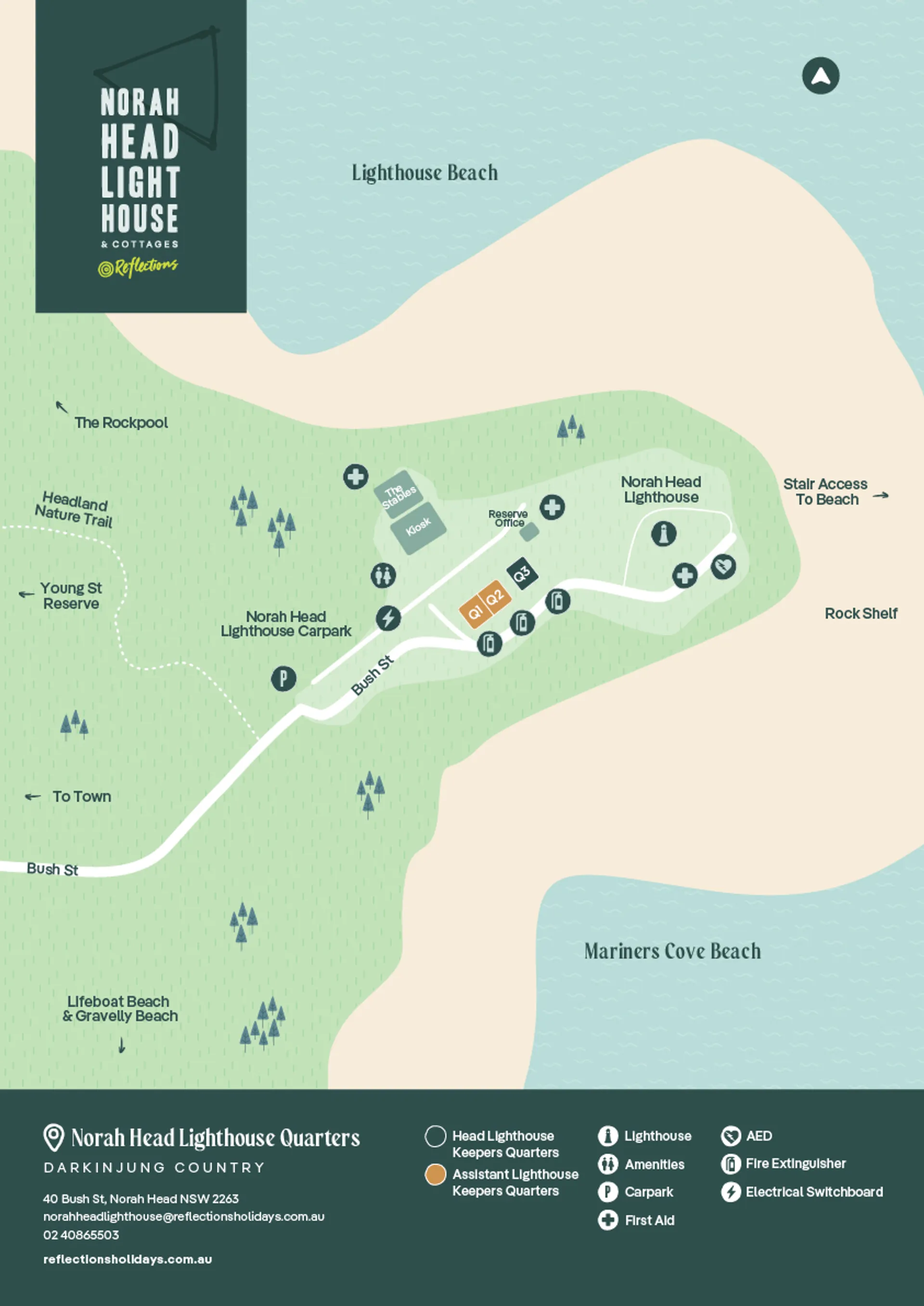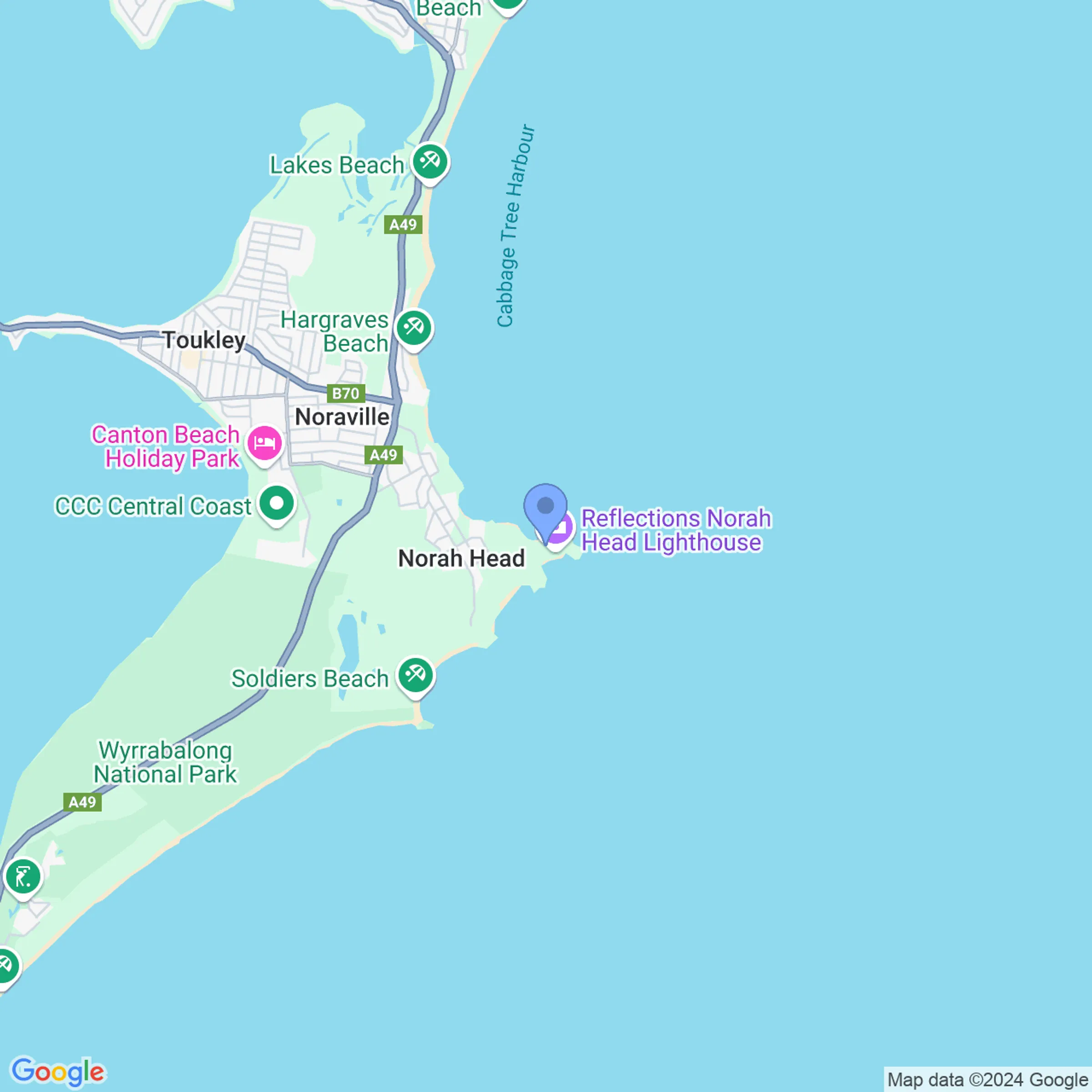What others are sharing


What's included ?
Where you will sleep
Location map

Amenities
Location
Phone
(02) 4086 5503
9am - 5pm

Frequently asked questions
The lighthouse is 27 metres in height.
Norah Head Lighthouse Loop Walk is 2.5km, grade 4 hike that typically takes 1.25 hours to complete.
The Latin inscription etched on the glass of the front door, "Olim Periculum Nunc Salus," translates to "Once Peril, Now Safety."
The tower stands at a height of 27 metres, with 96 stairs leading to its summit. The stairs are divided into four stages, the first three being of the same gradient while the final stage is slightly steeper and narrower. Constructed from pre-cast concrete blocks produced on-site and local aggregate, the building features a tiled ground floor, a bluestone balcony, and gunmetal railings.
The lighthouse lens, a Fresnel design dating back to the late 17th century, consists of 700 prisms and weighs 5 tonnes. Utilising a bi-valve structure, each side concentrates light received from a source across its entire surface area into a single, intense beam, surpassing the source's brightness by 1000 times. Originally operated manually from its opening in 1903 until electricity was installed in 1961, the lens rotation relied on a mechanical weight and clockwork mechanism, requiring the lightkeeper to wind it every four hours. Following the installation of an electric motor in 1961, only one lightkeeper was needed for operation, thanks to the efficient suspension system, which requires only a 200W motor to maintain rotation.
The ground floor accommodates an entry hallway and two rooms. One room, initially designated as the Report Room and later repurposed as a radio room, served as the administrative hub for lightkeepers, where they maintained records, filled logbooks, and recorded daily activities and weather reports. Acting as the primary station for Montague Island in the south and South Solitary Island in the north, Norah Head coordinated communication. The second room, now the Plant Room, houses emergency generator equipment, electrical controls, and a workshop. In the event of a power failure, the generator activates within seconds, powered by its local diesel supply, ensuring continuous power to the lighthouse. Displayed on the wall are hand tools typical of the era, alongside museum artifacts recovered from local shipwrecks.
Adjacent to the building, a "ghost door" remains unfinished, likely due to impracticalities caused by southerly winds.
Flag Locker Building Constructed to store over 40 flags used for daytime communication between passing ships and the lighthouse, this building housed international maritime code flags established in 1857. These flags conveyed messages such as distress signals, weather forecasts, and navigational hazards, employing a graphical language accessible to all nationalities.
Weather Station Originally situated 100 metres uphill, the primary weather station at Norah Head Lighthouse coordinated reports from South Solitary Island and Montague Island before transmitting data to the Sydney Bureau. The current weather station electronically transmits information directly to the Bureau of Meteorology in Sydney.
Fresh Water Tanks The grounds feature underground water tanks, including a sealed condensation water tank beneath the tower, holding approximately 30,000 litres to stabilize the tower's foundation.
Landforms The immediate vicinity boasts a unique rock platform dating back to the Triassic to Permian era, around 180 to 280 million years ago. From atop the lighthouse, a visible volcanic intrusion, likely originating from Mt. Warrowolong to the west of Norah Head, showcases a channel carved by softer basalt lava, surrounded by harder granite, formed over eons by the relentless force of waves
Find out more about Norah Head Lighthouse volunteers here
Our Head Lightkeepers Quarters and two Assistant Lightkeepers' Quarters all have breathtaking ocean views.
For those looking to visit the reserve, dogs are permitted. However, all our accommodation offerings are not dog-friendly.
There are 3 cottages in total. 1 Head Lightkeepers Quarters and two Assistant Lightkeepers Quarters
Check-in for both the Lighthouse Keepers Quarters and the Assistant Lighthouse Keepers Quarters is from 2pm onwards.
If you plan to arrive after office hours (9:00am – 5:00pm) please let us know so that we can have all relevant documents waiting for your arrival.
Checkout from the Lighthouse Keepers Quarters and the Assistant Lighthouse Keepers Quarters is 10:00am.
Climb 96 stairs to experience breathtaking 360-degree views of the headland.
For all details please refer to our booking terms and conditions HERE.
Norah Head Lighthouse tours open daily between 10:00am and 1:30pm and weather permitted. Whale watching can be done from outside Norah Head Lighthouse each year from May to November hump-backed whales can be seen in close proximity to the coast as they migrate between the cold southern and warm northern oceans.
Yes - West of the quarters there is a lovely walking trail that takes you through natural bushland to the local cafes, shops and Rockpool. To the east leads to the steps down to the beach. Walking to the north for approximately 20 minutes will take you across the rock ledge and around the rock pool where it is safe to swim and to the local cafes and shops. Walking to the south for approximately 20 minutes will take you across Gravelly Beach and to Soldiers Beach Headland where you will find a cafe selling great coffee and light meals.
We recommend a maximum of 3 cars per cottage.1 car at quarters 2 additional cars on premises - Any other cars public parking outside the reserve.
Yes, its a 50-minute drive to Awaba mountain bike tracks or 40 minute drive to Central Coast mountain bike tracks Ourimbah.
Plenty of food and drink to have a great stay, there are plenty of local shops 10 minutes drive from Norah Head Lighthouse.
Find out everything about the history of Norah Head Lighthouse here.
The famed Norah Head Lighthouse, nestled on the Central Coast, stands as a cherished beacon for both locals and tourists, offering not only a glimpse into history but also serving as a charming venue for holidays, weddings and events. Erected from 1901 to 1903, this historic landmark continues to shine bright, drawing visitors from near and far.
Proudly managed by Reflections Holidays, serving as the appointed NSW Crown Lands Manager, the Norah Head Lighthouse Reserve thrives with the invaluable assistance of approximately 50 enthusiastic volunteers. These volunteers lead guided tours, run the charming kiosk shop, maintain and preserve the site's accommodation and vast natural surroundings. Thanks to their great care and dedication, the quaint Lighthouse Keeper’s Quarters and Assistant Lighthouse Keeper’s Quarters remain available for holiday bookings for visitors and locals to enjoy.
Reflections’ lauds the volunteers' ongoing commitment, emphasising their role in upkeeping this public treasure. Proceeds from tours, kiosk, wedding ceremonies and holiday bookings are reinvested into maintaining the lighthouse and its surroundings, with additional support welcomed from generous donors.
Recognised for its cultural significance, beautiful land and seascapes, and quality accommodation, the reserve has earned accolades and awards, affirming its status as a cherished community asset.
Ultimately, the success of the Norah Head Lighthouse Reserve hinges on effective management, dedicated volunteers, and unwavering support from the local community.
For all drone permission and approvals, please visit the NSW Government Parks and Policies approval guidelines webpage.
Additional Resources
For further guidance on drone operation in public spaces, consult:
Access to this beautiful beach is only via the 132 stairs, but the clear water and superb views of the Norah Head lighthouse make it worth the trek!
Yes. Dunes by Dish is an excellent tapas bar and restaurant with great beach views.
Electric Vehicle charging is only permitted at designated Electric Vehicle stations at Reflections Holidays. Reflections Norah Head Lighthouse does not currently have an EV Charging Station. Please view the NSW Charging Map to find your nearest charging point.
Charging an electric vehicle on campsites or at any of roofed accommodation is not permitted.
View parks with designated electric vehicle charging points.




